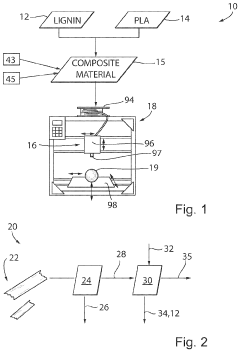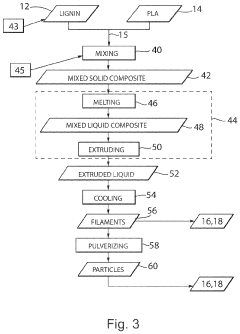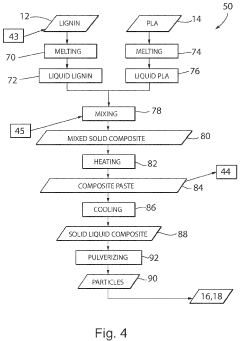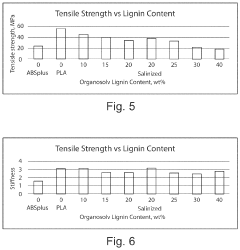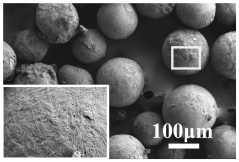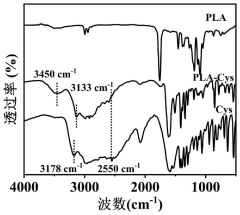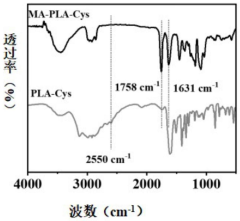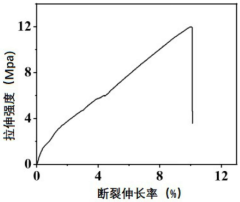How to Achieve High-Quality Finishes with PLA in 3D Printing?
JUN 25, 20259 MIN READ
Generate Your Research Report Instantly with AI Agent
Patsnap Eureka helps you evaluate technical feasibility & market potential.
PLA Finishing Challenges
PLA (Polylactic Acid) is a popular material in 3D printing due to its ease of use and biodegradability. However, achieving high-quality finishes with PLA presents several challenges that need to be addressed to produce professional-looking prints.
One of the primary challenges is layer visibility. PLA prints often exhibit visible layer lines, which can detract from the overall aesthetic of the finished product. This issue is particularly noticeable on curved surfaces and can be exacerbated by larger layer heights. Overcoming this challenge requires careful calibration of print settings and potentially post-processing techniques.
Surface roughness is another significant hurdle in PLA finishing. Even with optimal print settings, PLA parts can have a slightly rough texture, especially on top surfaces or overhangs. This roughness can be particularly problematic when creating parts that require a smooth, polished appearance or need to interact with other components.
Warping and shrinkage pose additional challenges in achieving high-quality finishes. PLA is prone to warping, especially on large, flat surfaces or when printing at higher temperatures. This can lead to deformation of the part, affecting both its appearance and functionality. Shrinkage, while less pronounced in PLA compared to some other materials, can still cause dimensional inaccuracies that impact the final finish.
Post-processing PLA presents its own set of challenges. Unlike some other materials, PLA has a relatively low glass transition temperature, making it more sensitive to heat-based smoothing techniques. This sensitivity can limit the effectiveness of certain post-processing methods and requires careful consideration when selecting finishing approaches.
Adhesion issues can also affect the quality of PLA prints. Poor bed adhesion can lead to warping or detachment during printing, resulting in failed prints or parts with compromised surface quality. Conversely, excessive adhesion can make it difficult to remove the print without damaging the surface, potentially ruining an otherwise well-printed part.
Color consistency and surface finish uniformity are additional challenges, particularly when printing large parts or combining multiple printed components. PLA can exhibit slight variations in color and surface texture between different filament batches or even within the same print, which can be noticeable in the final product.
Achieving sharp details and fine features with PLA can be challenging, especially for intricate designs. The material's properties and typical printing temperatures can lead to slight rounding of edges or loss of detail in very small features, requiring careful tuning of print parameters to maintain precision.
One of the primary challenges is layer visibility. PLA prints often exhibit visible layer lines, which can detract from the overall aesthetic of the finished product. This issue is particularly noticeable on curved surfaces and can be exacerbated by larger layer heights. Overcoming this challenge requires careful calibration of print settings and potentially post-processing techniques.
Surface roughness is another significant hurdle in PLA finishing. Even with optimal print settings, PLA parts can have a slightly rough texture, especially on top surfaces or overhangs. This roughness can be particularly problematic when creating parts that require a smooth, polished appearance or need to interact with other components.
Warping and shrinkage pose additional challenges in achieving high-quality finishes. PLA is prone to warping, especially on large, flat surfaces or when printing at higher temperatures. This can lead to deformation of the part, affecting both its appearance and functionality. Shrinkage, while less pronounced in PLA compared to some other materials, can still cause dimensional inaccuracies that impact the final finish.
Post-processing PLA presents its own set of challenges. Unlike some other materials, PLA has a relatively low glass transition temperature, making it more sensitive to heat-based smoothing techniques. This sensitivity can limit the effectiveness of certain post-processing methods and requires careful consideration when selecting finishing approaches.
Adhesion issues can also affect the quality of PLA prints. Poor bed adhesion can lead to warping or detachment during printing, resulting in failed prints or parts with compromised surface quality. Conversely, excessive adhesion can make it difficult to remove the print without damaging the surface, potentially ruining an otherwise well-printed part.
Color consistency and surface finish uniformity are additional challenges, particularly when printing large parts or combining multiple printed components. PLA can exhibit slight variations in color and surface texture between different filament batches or even within the same print, which can be noticeable in the final product.
Achieving sharp details and fine features with PLA can be challenging, especially for intricate designs. The material's properties and typical printing temperatures can lead to slight rounding of edges or loss of detail in very small features, requiring careful tuning of print parameters to maintain precision.
Market Demand Analysis
The market demand for high-quality finishes with PLA in 3D printing has been steadily increasing in recent years. This growth is driven by the expanding applications of 3D printing across various industries, including manufacturing, healthcare, education, and consumer goods. PLA (Polylactic Acid) has become a popular choice for 3D printing due to its biodegradability, ease of use, and relatively low cost.
In the manufacturing sector, there is a growing need for prototypes and end-use parts with superior surface quality. Companies are seeking ways to reduce post-processing time and costs while maintaining high-quality finishes. This demand is particularly strong in industries such as automotive, aerospace, and consumer electronics, where aesthetics and precision are crucial.
The healthcare industry has also shown significant interest in high-quality PLA prints. Medical models, surgical guides, and custom prosthetics require smooth surfaces and accurate details. The ability to achieve these finishes directly from the printer can greatly improve the efficiency of medical device production and reduce the risk of contamination during post-processing.
Education and research institutions are another key market segment driving the demand for high-quality PLA finishes. As 3D printing becomes more integrated into STEM curricula, there is a growing need for printers that can produce detailed, visually appealing models for educational purposes. Research laboratories also require high-quality prints for various applications, from molecular modeling to archaeological reconstructions.
The consumer market for 3D printing has been expanding, with hobbyists and small businesses seeking ways to produce professional-looking products. This segment demands printers and materials that can deliver smooth surfaces and fine details without extensive post-processing, as many users lack the resources or expertise for complex finishing techniques.
The global 3D printing market size was valued at USD 13.84 billion in 2021 and is expected to grow at a compound annual growth rate (CAGR) of 20.8% from 2022 to 2030. While this figure encompasses all 3D printing technologies and materials, the demand for high-quality PLA finishes is a significant contributor to this growth.
Market research indicates that customers are willing to pay a premium for 3D printers and materials that can deliver superior surface quality without the need for extensive post-processing. This trend is driving innovation in printer hardware, software, and PLA formulations designed to enhance print quality directly off the printer bed.
As the 3D printing industry continues to mature, the focus on achieving high-quality finishes with PLA is likely to intensify. This demand is expected to drive further research and development in areas such as nozzle design, temperature control, and material science to meet the growing expectations for print quality across various sectors.
In the manufacturing sector, there is a growing need for prototypes and end-use parts with superior surface quality. Companies are seeking ways to reduce post-processing time and costs while maintaining high-quality finishes. This demand is particularly strong in industries such as automotive, aerospace, and consumer electronics, where aesthetics and precision are crucial.
The healthcare industry has also shown significant interest in high-quality PLA prints. Medical models, surgical guides, and custom prosthetics require smooth surfaces and accurate details. The ability to achieve these finishes directly from the printer can greatly improve the efficiency of medical device production and reduce the risk of contamination during post-processing.
Education and research institutions are another key market segment driving the demand for high-quality PLA finishes. As 3D printing becomes more integrated into STEM curricula, there is a growing need for printers that can produce detailed, visually appealing models for educational purposes. Research laboratories also require high-quality prints for various applications, from molecular modeling to archaeological reconstructions.
The consumer market for 3D printing has been expanding, with hobbyists and small businesses seeking ways to produce professional-looking products. This segment demands printers and materials that can deliver smooth surfaces and fine details without extensive post-processing, as many users lack the resources or expertise for complex finishing techniques.
The global 3D printing market size was valued at USD 13.84 billion in 2021 and is expected to grow at a compound annual growth rate (CAGR) of 20.8% from 2022 to 2030. While this figure encompasses all 3D printing technologies and materials, the demand for high-quality PLA finishes is a significant contributor to this growth.
Market research indicates that customers are willing to pay a premium for 3D printers and materials that can deliver superior surface quality without the need for extensive post-processing. This trend is driving innovation in printer hardware, software, and PLA formulations designed to enhance print quality directly off the printer bed.
As the 3D printing industry continues to mature, the focus on achieving high-quality finishes with PLA is likely to intensify. This demand is expected to drive further research and development in areas such as nozzle design, temperature control, and material science to meet the growing expectations for print quality across various sectors.
Current PLA Limitations
PLA (Polylactic Acid) has become a popular material in 3D printing due to its ease of use and biodegradability. However, achieving high-quality finishes with PLA presents several challenges that limit its applications in certain industries.
One of the primary limitations of PLA is its susceptibility to warping and shrinkage during the cooling process. As the material cools, it contracts unevenly, leading to deformation of the printed object. This can result in poor dimensional accuracy and surface quality, particularly in larger prints or those with complex geometries.
Another significant limitation is PLA's relatively low heat resistance. With a glass transition temperature of around 60°C, PLA parts can soften and deform under moderate heat exposure. This restricts its use in applications that require thermal stability, such as automotive or aerospace components.
PLA also exhibits lower impact strength and durability compared to other 3D printing materials like ABS or PETG. This brittleness can lead to easier breakage of printed parts, especially those subjected to mechanical stress or repeated use.
Surface finish quality is another area where PLA faces challenges. While it can produce smooth surfaces, achieving a glossy or high-polish finish often requires post-processing techniques. The material's sensitivity to moisture can also affect surface quality, as absorbed water can cause bubbling or inconsistencies during printing.
Layer adhesion is a critical factor in 3D printing, and PLA sometimes struggles in this aspect. Inadequate layer bonding can result in weak points in the printed object, compromising its structural integrity and overall quality.
PLA's limited chemical resistance poses challenges in certain applications. It is susceptible to degradation when exposed to various solvents and chemicals, restricting its use in environments where such exposure is common.
The material's biodegradability, while an environmental advantage, can be a limitation in long-term applications. PLA can degrade over time, especially in high-humidity environments, affecting the longevity and stability of printed objects.
Lastly, achieving consistent color and transparency with PLA can be challenging. Variations in printing conditions and material batches can lead to inconsistencies in the final appearance of printed objects, which is particularly problematic in applications requiring precise color matching or optical clarity.
One of the primary limitations of PLA is its susceptibility to warping and shrinkage during the cooling process. As the material cools, it contracts unevenly, leading to deformation of the printed object. This can result in poor dimensional accuracy and surface quality, particularly in larger prints or those with complex geometries.
Another significant limitation is PLA's relatively low heat resistance. With a glass transition temperature of around 60°C, PLA parts can soften and deform under moderate heat exposure. This restricts its use in applications that require thermal stability, such as automotive or aerospace components.
PLA also exhibits lower impact strength and durability compared to other 3D printing materials like ABS or PETG. This brittleness can lead to easier breakage of printed parts, especially those subjected to mechanical stress or repeated use.
Surface finish quality is another area where PLA faces challenges. While it can produce smooth surfaces, achieving a glossy or high-polish finish often requires post-processing techniques. The material's sensitivity to moisture can also affect surface quality, as absorbed water can cause bubbling or inconsistencies during printing.
Layer adhesion is a critical factor in 3D printing, and PLA sometimes struggles in this aspect. Inadequate layer bonding can result in weak points in the printed object, compromising its structural integrity and overall quality.
PLA's limited chemical resistance poses challenges in certain applications. It is susceptible to degradation when exposed to various solvents and chemicals, restricting its use in environments where such exposure is common.
The material's biodegradability, while an environmental advantage, can be a limitation in long-term applications. PLA can degrade over time, especially in high-humidity environments, affecting the longevity and stability of printed objects.
Lastly, achieving consistent color and transparency with PLA can be challenging. Variations in printing conditions and material batches can lead to inconsistencies in the final appearance of printed objects, which is particularly problematic in applications requiring precise color matching or optical clarity.
Existing PLA Solutions
01 Surface treatment techniques for PLA
Various surface treatment techniques can be applied to improve the finish quality of PLA. These methods include plasma treatment, corona discharge, and chemical etching. Such treatments can enhance surface properties like adhesion, wettability, and printability, leading to improved finish quality and overall performance of PLA products.- Surface treatment techniques for PLA: Various surface treatment techniques can be applied to improve the finish quality of PLA. These methods include plasma treatment, corona discharge, and chemical etching. Such treatments can enhance surface properties like adhesion, wettability, and printability, leading to improved finish quality and overall performance of PLA products.
- Additives for enhancing PLA finish quality: Incorporating specific additives into PLA formulations can significantly improve its finish quality. These additives may include plasticizers, impact modifiers, and nucleating agents. By carefully selecting and optimizing these additives, manufacturers can achieve better surface smoothness, gloss, and overall aesthetic appeal in PLA products.
- Processing parameters optimization: Optimizing processing parameters during PLA manufacturing and finishing can greatly influence the final surface quality. Factors such as temperature control, cooling rate, and molding pressure play crucial roles. Fine-tuning these parameters can lead to improved surface finish, reduced defects, and enhanced overall quality of PLA products.
- Blending PLA with other polymers: Blending PLA with other compatible polymers can improve its finish quality and overall performance. This approach can enhance properties such as impact resistance, thermal stability, and surface smoothness. Careful selection of blend components and ratios is essential to achieve the desired finish quality while maintaining PLA's biodegradability.
- Post-processing techniques for PLA: Various post-processing techniques can be applied to enhance the finish quality of PLA products. These may include polishing, coating, annealing, and surface texturing. Such methods can improve surface smoothness, gloss, and overall aesthetic appeal, as well as enhance functional properties like scratch resistance and durability.
02 Additives for enhancing PLA finish quality
Incorporating specific additives into PLA formulations can significantly improve its finish quality. These additives may include plasticizers, impact modifiers, and nucleating agents. By carefully selecting and optimizing these additives, manufacturers can achieve better surface smoothness, gloss, and overall aesthetic appeal in PLA products.Expand Specific Solutions03 Post-processing techniques for PLA
Various post-processing techniques can be employed to enhance the finish quality of PLA products. These may include annealing, polishing, and coating applications. Such processes can help improve surface smoothness, reduce defects, and increase the overall aesthetic appeal and durability of PLA-based items.Expand Specific Solutions04 Optimizing processing parameters for PLA
Careful adjustment of processing parameters during PLA manufacturing can significantly impact the finish quality. This includes optimizing factors such as temperature, pressure, and cooling rates during extrusion, injection molding, or 3D printing processes. Fine-tuning these parameters can lead to improved surface finish, reduced warping, and enhanced overall product quality.Expand Specific Solutions05 Blending PLA with other polymers
Blending PLA with other compatible polymers can improve its finish quality and overall performance. This approach can enhance properties such as impact resistance, flexibility, and surface smoothness. Careful selection of blend components and ratios can result in PLA-based materials with superior finish quality and tailored characteristics for specific applications.Expand Specific Solutions
Key 3D Printing Players
The 3D printing industry, particularly in achieving high-quality finishes with PLA, is in a growth phase with increasing market size and technological advancements. The competitive landscape is diverse, featuring both established players and innovative startups. Companies like Kingfa Sci. & Tech. Co., Ltd. and BYK-Chemie GmbH are contributing to material improvements, while DyeMansion GmbH focuses on post-processing technologies. Universities such as Nanjing Tech University and South China Agricultural University are driving research in this field. The technology's maturity is progressing, with firms like Photocentric Ltd. and Impossible Objects LLC pushing boundaries in print quality and finish. Overall, the industry is seeing a convergence of material science, hardware innovations, and post-processing techniques to enhance PLA finish quality in 3D printing.
Kingfa Sci. & Tech. Co., Ltd.
Technical Solution: Kingfa has developed a specialized PLA formulation and processing technique for high-quality 3D printing finishes. Their approach involves modifying the PLA polymer structure to improve its printability and surface characteristics. They use additives that enhance the material's flow properties during printing, resulting in smoother layer lines. Post-printing, they apply a proprietary heat treatment process that further smooths the surface without compromising the part's structural integrity. This is combined with a mechanical polishing step using nano-abrasives to achieve a high-gloss finish.
Strengths: Improved material properties, suitable for various applications. Weaknesses: May require specific printer settings, potential higher material cost.
BYK-Chemie GmbH
Technical Solution: BYK-Chemie has developed additives specifically designed to enhance the surface quality of 3D printed PLA parts. Their approach involves incorporating these additives into the PLA filament during manufacturing. These additives work by improving the flow characteristics of the molten PLA during printing, resulting in smoother layer lines and reduced surface imperfections. Additionally, they've created post-processing solutions that can be applied to the printed parts. These include a specially formulated coating that fills in minor surface irregularities and provides a smooth, glossy finish without the need for extensive sanding or polishing.
Strengths: Easy to implement, compatible with existing printing processes. Weaknesses: May slightly alter material properties, additional cost for additives.
Core PLA Innovations
Polyactic Acid and Lignin Composite Thermoplastic for 3D Printing
PatentInactiveUS20210171764A1
Innovation
- A composite thermoplastic material is developed by blending purified polylactic acid (PLA) with high amounts of purified lignin, using a silane coupling agent to improve compatibility, and optionally incorporating carbon fibers, which enhances mechanical properties and thermal stability, while being environmentally friendly and cost-effective.
Modified powder suitable for three-dimensional ink-jet printing and printing forming method thereof
PatentPendingCN117700703A
Innovation
- Amines or acids with thiol groups are used as modifiers to react with polymer powder to prepare thiol-modified powder, and are combined with olefin inks through thiol-ene click reactions to achieve rapid solidification and molding of PLA powder.
Environmental Impact
The environmental impact of achieving high-quality finishes with PLA in 3D printing is a crucial consideration in the broader context of sustainable manufacturing. PLA (Polylactic Acid) is widely regarded as an eco-friendly alternative to petroleum-based plastics due to its biodegradable nature and renewable source materials. However, the process of achieving high-quality finishes can introduce additional environmental factors that merit careful examination.
One of the primary environmental benefits of using PLA for high-quality 3D printing is its biodegradability. Under proper conditions, PLA can decompose within 3-6 months, significantly reducing long-term environmental impact compared to traditional plastics. This characteristic is particularly advantageous when considering the disposal of failed prints or support structures, which are common byproducts of the 3D printing process.
The production of PLA itself has a lower carbon footprint compared to many other plastics. It is derived from renewable resources such as corn starch or sugarcane, which absorb CO2 during growth. This results in a net reduction of greenhouse gas emissions throughout the material's lifecycle. However, it's important to note that the agricultural practices used to grow these feedstocks can have their own environmental implications, including water usage and potential land-use changes.
When focusing on achieving high-quality finishes, the environmental impact can be influenced by post-processing techniques. Many methods to enhance surface quality, such as sanding or chemical treatments, may introduce additional waste or potentially harmful substances. For instance, fine particulates from sanding can contribute to air pollution if not properly contained, while chemical smoothing agents may pose risks to water systems if improperly disposed of.
Energy consumption is another critical factor to consider. While 3D printing with PLA generally requires lower temperatures compared to other plastics, achieving high-quality finishes often involves extended print times or multiple iterations. This increased energy usage can offset some of the material's inherent environmental benefits. Implementing energy-efficient printing practices and utilizing renewable energy sources can help mitigate this impact.
The durability of high-quality PLA prints also plays a role in their environmental footprint. Improved surface finishes and overall print quality can lead to longer-lasting products, reducing the need for replacements and thereby decreasing overall material consumption and waste generation. This longevity aspect is an important consideration when evaluating the full lifecycle environmental impact of 3D printed PLA products.
In conclusion, while PLA offers significant environmental advantages in 3D printing, the pursuit of high-quality finishes introduces complexities that require careful consideration to maintain its eco-friendly status. Balancing the benefits of biodegradability and renewable sourcing with the potential impacts of post-processing and energy consumption is key to maximizing the environmental sustainability of high-quality PLA 3D printing.
One of the primary environmental benefits of using PLA for high-quality 3D printing is its biodegradability. Under proper conditions, PLA can decompose within 3-6 months, significantly reducing long-term environmental impact compared to traditional plastics. This characteristic is particularly advantageous when considering the disposal of failed prints or support structures, which are common byproducts of the 3D printing process.
The production of PLA itself has a lower carbon footprint compared to many other plastics. It is derived from renewable resources such as corn starch or sugarcane, which absorb CO2 during growth. This results in a net reduction of greenhouse gas emissions throughout the material's lifecycle. However, it's important to note that the agricultural practices used to grow these feedstocks can have their own environmental implications, including water usage and potential land-use changes.
When focusing on achieving high-quality finishes, the environmental impact can be influenced by post-processing techniques. Many methods to enhance surface quality, such as sanding or chemical treatments, may introduce additional waste or potentially harmful substances. For instance, fine particulates from sanding can contribute to air pollution if not properly contained, while chemical smoothing agents may pose risks to water systems if improperly disposed of.
Energy consumption is another critical factor to consider. While 3D printing with PLA generally requires lower temperatures compared to other plastics, achieving high-quality finishes often involves extended print times or multiple iterations. This increased energy usage can offset some of the material's inherent environmental benefits. Implementing energy-efficient printing practices and utilizing renewable energy sources can help mitigate this impact.
The durability of high-quality PLA prints also plays a role in their environmental footprint. Improved surface finishes and overall print quality can lead to longer-lasting products, reducing the need for replacements and thereby decreasing overall material consumption and waste generation. This longevity aspect is an important consideration when evaluating the full lifecycle environmental impact of 3D printed PLA products.
In conclusion, while PLA offers significant environmental advantages in 3D printing, the pursuit of high-quality finishes introduces complexities that require careful consideration to maintain its eco-friendly status. Balancing the benefits of biodegradability and renewable sourcing with the potential impacts of post-processing and energy consumption is key to maximizing the environmental sustainability of high-quality PLA 3D printing.
Post-Processing Methods
Post-processing methods play a crucial role in achieving high-quality finishes with PLA in 3D printing. These techniques are applied after the printing process to enhance the appearance, strength, and overall quality of the printed objects.
One of the most common post-processing methods for PLA prints is sanding. This technique involves using various grades of sandpaper to smooth out layer lines and imperfections on the surface of the printed object. Starting with coarse-grit sandpaper and gradually progressing to finer grits can result in a smooth, polished finish.
Another effective method is vapor smoothing, which utilizes chemical solvents to slightly melt the surface of the PLA print, creating a glossy and smooth finish. While acetone is not effective for PLA, alternative solvents such as ethyl acetate or tetrahydrofuran can be used. However, this method requires careful handling and proper safety precautions due to the volatile nature of these chemicals.
Heat treatment is another valuable post-processing technique for PLA prints. By carefully applying heat to the printed object, either through the use of a heat gun or an oven, the surface can be smoothed and layer lines can be reduced. This method also has the added benefit of increasing the overall strength and durability of the print.
Priming and painting are popular post-processing methods that can dramatically improve the appearance of PLA prints. Applying a primer helps to fill in small imperfections and provides a smooth base for paint application. Various types of paints, including acrylic and spray paints, can be used to add color and texture to the printed object.
For intricate designs or areas that are difficult to sand, filling and smoothing compounds can be employed. These products, such as epoxy resins or specialized 3D print fillers, can be applied to the surface of the print to fill in layer lines and imperfections. Once cured, these compounds can be sanded and painted to achieve a seamless finish.
Polishing is another technique that can be used to achieve a high-gloss finish on PLA prints. After sanding, various polishing compounds and tools, such as buffing wheels or polishing cloths, can be used to create a mirror-like surface on the printed object.
Lastly, protective coatings can be applied to enhance the durability and appearance of the finished print. Clear coats, such as polyurethane or acrylic sealers, not only protect the surface from scratches and UV damage but also add depth and shine to the final product.
One of the most common post-processing methods for PLA prints is sanding. This technique involves using various grades of sandpaper to smooth out layer lines and imperfections on the surface of the printed object. Starting with coarse-grit sandpaper and gradually progressing to finer grits can result in a smooth, polished finish.
Another effective method is vapor smoothing, which utilizes chemical solvents to slightly melt the surface of the PLA print, creating a glossy and smooth finish. While acetone is not effective for PLA, alternative solvents such as ethyl acetate or tetrahydrofuran can be used. However, this method requires careful handling and proper safety precautions due to the volatile nature of these chemicals.
Heat treatment is another valuable post-processing technique for PLA prints. By carefully applying heat to the printed object, either through the use of a heat gun or an oven, the surface can be smoothed and layer lines can be reduced. This method also has the added benefit of increasing the overall strength and durability of the print.
Priming and painting are popular post-processing methods that can dramatically improve the appearance of PLA prints. Applying a primer helps to fill in small imperfections and provides a smooth base for paint application. Various types of paints, including acrylic and spray paints, can be used to add color and texture to the printed object.
For intricate designs or areas that are difficult to sand, filling and smoothing compounds can be employed. These products, such as epoxy resins or specialized 3D print fillers, can be applied to the surface of the print to fill in layer lines and imperfections. Once cured, these compounds can be sanded and painted to achieve a seamless finish.
Polishing is another technique that can be used to achieve a high-gloss finish on PLA prints. After sanding, various polishing compounds and tools, such as buffing wheels or polishing cloths, can be used to create a mirror-like surface on the printed object.
Lastly, protective coatings can be applied to enhance the durability and appearance of the finished print. Clear coats, such as polyurethane or acrylic sealers, not only protect the surface from scratches and UV damage but also add depth and shine to the final product.
Unlock deeper insights with Patsnap Eureka Quick Research — get a full tech report to explore trends and direct your research. Try now!
Generate Your Research Report Instantly with AI Agent
Supercharge your innovation with Patsnap Eureka AI Agent Platform!
